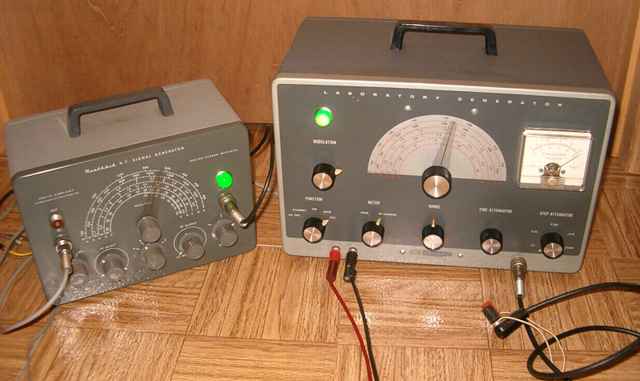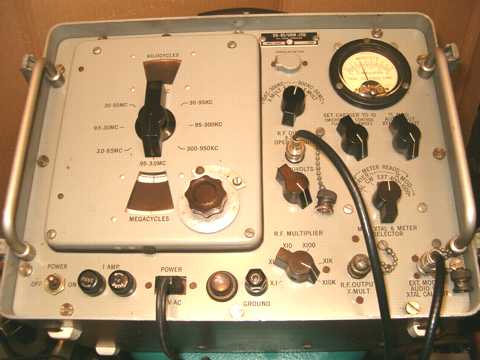Heath SG-8 (left) and Heath IG-42 (right)

Both of these Heathkit Signal Generators can be used as AM broadcasters using the external modulation input. Like most service type signal generators, both the SG-8 and the IG-42 are rated at 100,000 microvolts at an output impedance of 50 ohms. Very low power. They can also transmit at VLF (and other) frequencies making them fun for VLF-only receivers most of which would otherwise go unused.

Using the Heathkit SG-8 or the IG-42 as "broadcasters"
Both of these signal generators perform as expected as "broadcasters". Please note that the FCC limits antenna length to 10 feet. Power emitted by any of these signal generators is well below the limit set for non-licensed Part 15 devices. I have tested several other signal generators as broadcasters. Both Heathkits performed about as well as an Eico 324 in similar set-ups. Here are the complete details on the hook-up connections and results of tests with an Eico 324 Signal Generator as broadcaster..
The Heathkit IG-42 Lab Signal Generator with its more sophisticated circuitry should be able to outperform the other simpler signal generators such as the SG-8 and the Eico 324, but the output levels, per factory specifications, are the same for both Heath units as well as the Eico and that is apparently the limiting factor. All of the signal generators covered the entire house and my detached garage. The pattern was not totally circular, but reception ranged from good to excellent to a radius of about 50 feet, dropping off very rapidly after that. The range was affected by the frequency with the range of 1240 to 1400 giving some of the best results. This may have been due to the match to the 10 feet long piece of wire as draped around the door frame of my shop.
Increasing the signal from the IG-42
The IG-42 and the earlier near-identical Heathkit LG-1 (difference between the two is mostly cosmetic), as "Laboratory" Signal Generators are capable of much more output given the separate 6AF4 RF oscillator tube, the voltage regulator, and the rather potent 6AV5 RF amp tube. However, the factory attenuator includes a 510 ohm resistor in series with a 50 ohm network. This cuts the RF output of the tube by a factor of 10 which, of course, limits the output to published specifications of 0.1 volt at 50 ohms. Shorting out that resistor gave a much stronger signal. The original coax lead also has a 50 ohm termination resistor that limits the output. Using a direct lead to a 10 feet length of wire antenna increased the signal strength. These simple changes provided at least twice the coverage distance of the standard factory capability for the same quality of signal. The increased power still does not exceed the maximum allowed for Part 15 unlicensed devices.
Let me know about your experiments with and stories of using signal generators as broadcasters.
Here is a related link for restoring a 1930's Supreme model 570 Signal Generator which was also tested as a broadcaster.
Using an URM-25
I had a good laugh reading this story sent in by WA0EAJ.
Testing my SG85/ URM-25D as a wireless broadcaster
After getting Tom's note, I decided to test my URM-25D to see what sort of results it would provide.

SG-8 experiences
I received the following note from Glen, ex -VE3EUK, VE4GC, VE3PFI, VE3RZ
1. When I was a young teenager I connected a carbon microphone (salvaged from an old telephone) between my SG-8 RF output and an attic wire antenna about 30 feet long normally used for my SWL hobby. The carbon mike did the amplitude modulation and range was about 100 feet to a car radio. Never did manage to get a QSO out of this bootleg QRP setup.
2. When listening to SSB hams on the general coverage living room shortwave receiver with no BFO, the SG-8 when carefully tuned to the same frequency acted as a BFO and made the SSB intelligible.
3. A code key in place of the carbon mike at the SG-8 RF output with the SG-8 400 Hz modulation turned on and any RX made a quickie code practice oscillator when I studied for my ham radio license.
4. Could connect the speaker output of an electronic organ to the SG-8 modulation input and tune the living room HiFi on the FM broadcast band for added sound coverage.
5. Still have the SG-8 and a couple years ago used it and a scope to trace out alarm system wiring in the wall. Squirrels had chewed through a cable to some window sensors, but by driving the attic end of the cable with the SG-8 could pick up RF with the scope probe and locate the other cable end while still inside the wall and with the cable chewed through. (A portable radio instead of the scope would have worked too, but I did not have a portable radio handy.) This let me chop into the wall at the right place near the window sensors and run a new cable outside the house. Amazing what an old sig genny can be used for.
Great stories, Glen! Using it to trace a hidden wire is a new one for me. Excellent use of a tool many of us already have.
Beware harmonics
All of these signal generators and wireless broadcasters put out a fair amount of harmonic content. Check the neighborhood for a signal at twice or three times or other multiple of the fundamental frequency to assure that it is not interfering with some neighbor's reception of a frequency important to them. I suppose a standard low pass L antenna tuner circuit would do much to eliminate the harmonics. (A low pass L-tuner means a coil in series and a capacitor in parallel.)
A HomeBrew Transmitter for the 6 meter ham band was the previous item on the bench.